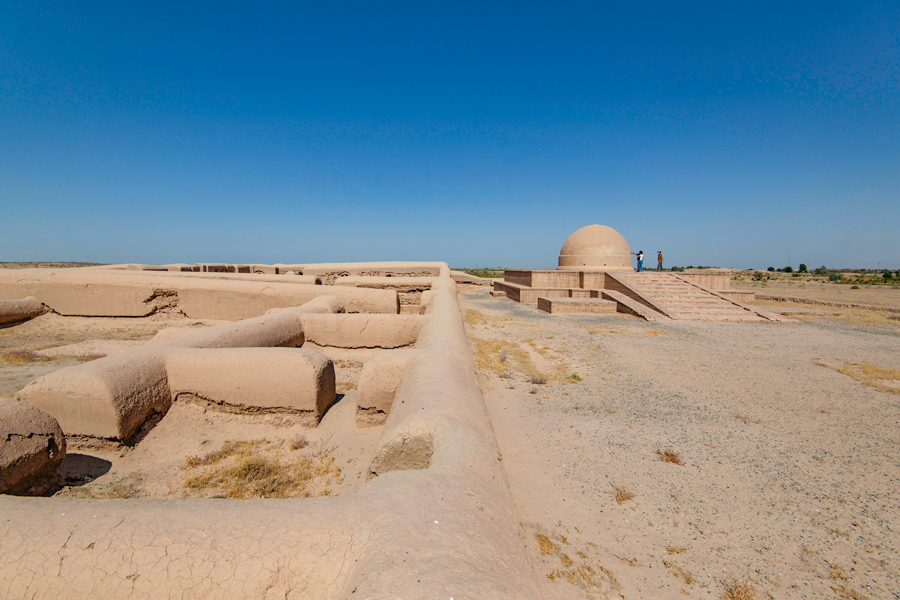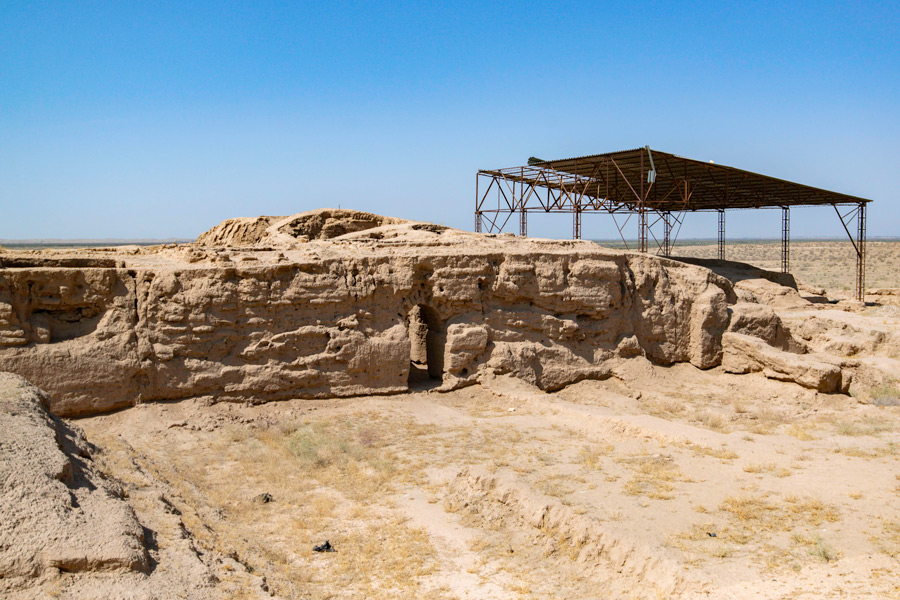
Buddism played a considerable part in the ideology of ancient Termez for seven centuries I - VII (AD).Buddhism is a religious and philosophical doctrine that appeared in North India in VI century BC. The Buddha's followers professed it on the territory of Hindostan for several centuries; then it emerged out of India and spread all over the world, becoming a world religion. Among the areas that first attracted missionaries was Central Asia. Bactria was the Central Asian region where Buddhist missionaries came. However, scholars are now addressing the question of when it happened.
Indian researchers mark the starting point of spread of Buddhism with the III (third) Buddhist council. It was held in the reign of Ashok's (Maury dynasty-261-222 BC), who was famous as a protector of Buddhism. The decision to profess Buddhism and spread it all over the world was made in the council.
In the opinion of E. Rtveladze, Buddhism came to central Asia a bit later in the years of Greekk-Bactrian Empire. Buddhism had a stable in Bactria and West India (Yandharu) at time. He supports his opinion by the coins of the Greek and Bactrian king Agathocles (185 - 170 B.C.) on which there is a Buddhist "stupa".
The famous researcher of Central Asian , B. Litvinsky, considers that Buddhism's influence in Bactria can be dated back to the pre- Kushan and early Kushan period. His view is based on evidence dating back to the first century, BC-first century AD.
Based on archaeological evidence from Buddhist monuments in North Bactria, B. Stavinsky supposed that Buddhism could be found in Bactria during the reign of the famous Kushan ruler Kanishka (end of the 1st - the beginning of the 2nd AD).
A critical analysis of all the materials on that problem, including evidence of Buddhism's infiltration into China (5), was made by B. Mukerji. He came to the conclusion that Buddhism was well known in Central Asia, particularly in Bactria in the middle of the 1st century BC.
This idea is verified with the coins of Kushan tsar Sotep Metas-Vima, the predecessor of Kanishki. These coins were found in reliable stratigraphic conditions in a number of Buddhist monuments in North Bactria - Ayrtam (7), Fayaztepa (8) Karatepa.

All this evidence helps us to picture the spread of Buddhism in Central Asia in the following way. Buddhist missionaries might have begun professing Buddhism in Bactria in II centuries BC. But the wide-spread building of Buddhist cult monuments in North Bactria and the propagation of this doctrine in the region can be dated back only to the second half of the first century AD. That is the reason why Bactria and northwest India, where Buddhism the primary religion, were one Kushan state.
Archaeological evidence demonstrates that ancient Termez was one of the largest centres of Buddhism in the region. The first findings in the territory of Old Termez, fragments of Buddhist stone sculptures, were made by an expedition of the Oriental Museum under B. Denike in 1928. At that time, one of the participants of this expedition, A. Strelkov, inspected some caves in the northwest corner of the ancient city on the Karatepa hill. He interpreted them as the rooms of a Buddhist cave monastery. He further supposed that the hill in the southeast from the citadel of Old Termez - the Zurmal Tower could be the remnants of Buddha's stupa.
In 1961 a joint expedition under B. Stavinsky began to research Karatepa. This research lasted for years. Among the researchers were groups of Hermitage (T. Zeimal), State Oriental Museum (N. Sitcheva, A. Berdnikov, T.Mkrtichev), Samarkand Historical Museum Reservation (Yu. Davidyan), a group of restores of the State Restoration Institute (M. Shemakhanskaya, N. Kovalyova, L. Burkova, G. Versotskaya).
The finding of this multi year work was a group of unique Buddhist monuments, which were entered into the historical record as the Buddha Cult Centre of Karatepa. The final documents were published in six issues of Karatepa Expedition Materials. (11) Hundreds of articles, including research in architecture, iconography, ceramics, epigraphy, numismatics, different technical and technological aspects of the monuments were devoted to research into the Karatepa artefacts. The joint article written by B. and T. Mkrtichev contains the results of of the expedition. In it they studied the Buddha Cult Centre.
Further research was made by a joint Japan and edition under K. Kato (Japan) and Sh. Pidayev (Uzbekistan) in 1996. The results of the work were published both in Japan and in Uzbekistan.
Another Buddhist site, hill Fayaz-Tepe, situated in 1 km away to the northwest of Karatepa, and was studied by L. Albaum from 1968 to 1976. A large monastery was discovered at that site. (14) working in Old Termez, L. Albaum found the remnants of basements not far from the northeast corner of the old city. The artefacts found there helped Albaum to interpret the site as a part of a Buddha cult structure.

Thus, it is now acknowledged to be four Buddha Cult structures in the area of Old Termez. As well, a great number of stone architectural details, and decorated statues of Buddha have been found.
Another source on the history of Buddhism in Old Termez are terracotta statuettes of Buddha repertoire, which were found both as a result of archaeological research and during the process of collecting material in the territory of the ancient town site.
Summarizing the architectural evidence and ten sources (Evidence of China Pilgrims) we can picture the spread of Buddhism in ancient and early middle ages Termez and some peculiarities in the architecture and decoration in Termez.
In all probability in the middle of the 1st century A.D. in the northeast part of Kushan Termez many Buddha's cult monuments were built in Karatepa and Fayaztepa. An aqueduct might have been erected then to provide these monuments water. Its remains have been preserved as a running to the northeast part of Old Termez.
The Buddha cult centre in Karatepa was situated on a sandstone rise, consisting of three small hills, and occupied the area of about 7 hectares. As the archaeological work showed, the centre was a complex of separate buildings, constructed at different times. These included a cave west and south summits of Karatepa and surface structures northern summit.
The surface structures consisted of buildings made of bricks on the slopes of hills, and caves in the sandstone. The staircases witness that the buildings on the slopes had second storeys.
The variety in the design in the cave structures in Karatepa (Complexes according to Stavinsky) raised a lot of questions concerning their typology and application. However, a reconstruction of the sequence of construction and an analysis of the architecture and design of the Karatepa complexes show that Karatepa builders used two types of design for the surface structures - classical and corridorial.
The classical type of design consists of a square yard, with a cave in the form of a corridor around the central chamber and several niches - cells on the perimeter. This is based on the Buddha cave structures of Dean.
However, the design of the Karatepa complex differs considerably from this prototype. There are several processes that caused this transformation. First, the general purpose of Buddhist cave architecture is to join separate temples and monasteries into one structure. The researchers of this architecture date the beginning of this process back 1 century BC and the beginning of our era A.D. (21) Secondly, the simplicity of design that the masters living outside India followed during construction produced a corridor running around a central object.
It is unknown whether some Buddhist Monasteries were destroyed by the Arabs. However, to get rid of the heathen's temples in Central Asia, the Arabs used a practice of levying special taxies on non-Moslim cult objects still in existence. (54) This probably put an end to the function of Buddhist monuments in Termez and its surrounding area. Most likely, the monks living in the Buddhist monasteries of Termez moved to the region of Kashmir, where at that time the dynasty of the Karkots ruled and who were active supporters of Buddhism.
In VIII- IX centuries the majority of Tokharstan's population adopted the new religion that was brought by the Arabs. One of the causes of that non-Moslims had to pay huge taxes on territories. Thus, the adoption of Islam helped people reduce their taxes. It is among those who continued to hold were not only monks but ordinary people as well.
However, even though Buddhism lost its pre-eminence as a religion, it continued to influence the worldview of the Termez people. As an example of this we can take the literary works of famous the ologian - mystic Hakim at-Termizi (IX c.) in which researchers have found some elements of Buddhism.

